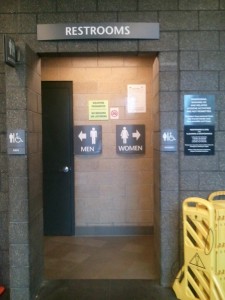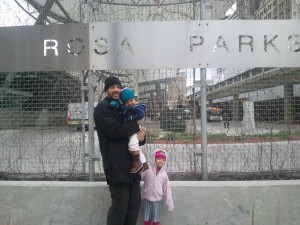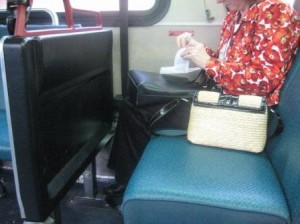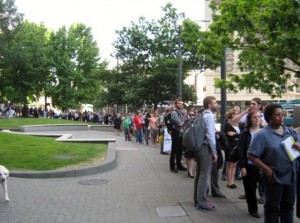Earlier this month, the four of us spent a week in Detroit (aka, my city-in-law), combining a work conference for me with a visit home (including a celebration of his childhood church’s 75th anniversary) for Bus Nerd. Per usual, I spent much of the visit indulging my Rosa Parks obsession, which included dragging everyone (including my Gail, who had actually already been) on a pilgrimage to the recently* completed Rosa Parks Transit Center.
On paper, the RPTC is everything a bus chick could dream of, and in real life, it lives up to the hype—at least, from the perspective of someone who didn’t actually ride any buses to or from it. It has a heated indoor waiting area; real-time arrival info; a booth selling passes, tickets, and et cetera; and (hands down best of all): a bathroom!
As most of you know, Mrs. Parks is one of my idols, for reasons far beyond the (often oversimplified) story of her refusal to give up her bus seat. To be able to bring my children (including my own Rosa) to an amazing public resource dedicated to her memory was an incredibly fulfilling experience.
It was also an incredibly depressing experience.
To say that Detroit’s bus system is in crisis would be an understatement. At one of the conference sessions I attended the day before my visit to the RPTC, I learned that Detroit is 9th in the nation in transit demand–due to the size of the city’s population and the fact that a third of its residents don’t have access to a private vehicle–but 109th in the nation in the service that is deployed to meet that demand. Vehicles are in such disrepair that, on any given day, over a quarter of the buses that should be in service aren’t running. The sytem is out of money** and failing Detroiters by almost every measure. The mayor recently announced that the city is seriously considering outsourcing its management to a private contractor.
So, Detroit has a state-of-the-art, envy-inspiring transit center, and essentially no transit service. Residents (the vast majority of whom are people of color) are regularly missing work, school, and medical appointments; being left stranded at stops at all times of day and night; and enduring unpleasant, overcrowded rides on poorly functioning vehicles.
Anyone who believes, as I do, that basic mobility is a civil right, has to wonder: What would Mrs. Parks think?
***
*It was officially completed in 2009, which fits my definition of “recently.”
**City buses are operated by DDOT and are paid for out of the general fund. The city is in such dire fiscal straits that it must essentially choose between public safety and basic mobility. The regional bus system (SMART) is also facing major funding challenges.




